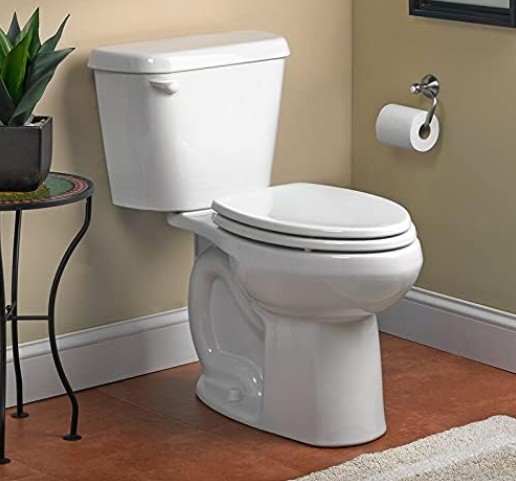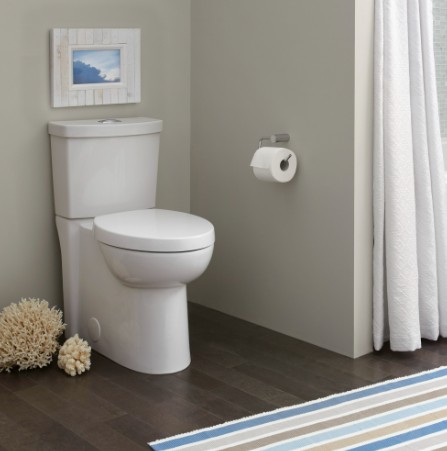If you are looking for comfort in a toilet, you won’t go wrong with American Standard models. The brand is renowned for making high-quality toilets, but brace yourself for some American Standard toilet flushing problems.
American Standard toilet flushing problems include weak flushes, ghost flushes, and clogging issues that can quickly turn your restroom into a source of frustration. These problems stem from multiple causes, such as misaligning toilet tank components and mineral deposits.
Familiarizing yourself with American Standard toilet flushing problems, causes, and solutions will help restore a smoothly functioning restroom environment.

Troubleshooting & Fixing American Standard Toilet Flushing Problems
The table below summarizes issues that could crop up when flushing American Standard toilets and how to handle them.
| Problem | Possible Cause | Recommended Fix | |
| 1. | Weak Flush | Toilet paper and other foreign material accumulation Corrosion debris in pipe walls | Plunging |
| 2. | Ghost Flushing | Defective gaskets Using pucks and discs | Replace defective gaskets Use recommended cleaning agents |
| 3. | Defective Flapper | Old/warped flapper | Replace the faulty flapper |
| 4. | Broken Lift Chain | Prolonged use | Replace the chain |
| 5. | Design Flaws In The Toilet Drain Pipe | Lack of a downward slope | Call plumbers |
| 6. | Blocked Inlet Holes | Bacteria and mineral deposits | Use water softeners |
| 7. | Low Water Levels In The Tank | Having below the water line | Fill the toilet tank to the water line |
1. Weak Flush
Experiencing a weak flush in your American Standard toilet is frustrating. When it happens, you will have to flush multiple times to whisk away waste, which could be a lingering concern if not addressed.
One common cause of sluggish flushes in American Standard toilets is the accumulation of toilet paper and other foreign materials within the pipes. When these materials build up, they create resistance within the plumbing system, reducing water pressure.
Corrosion debris also poses a significant challenge to the effective flushing of American Standard toilets. The rust or sediments infiltrate the inner walls of the pipes and compromise the integrity of the toilet’s flushing system. The result is a weakened flushing mechanism that fails to give a robust flush.
Moreover, misaligned components in the American Standard toilet tank also contribute to a weak flush. Improper installation of the flapper or the lift chain impedes the smooth water flow from the tank to the bowl, hence persistent sluggish flushes.
Fix
- Use a plunger to clear the toilet clog. Do this for 10–20 seconds.
- Flush to clean the toilet bowl.
- Experts recommend repeating the first two steps 2-3 times for desired results.
- If the weak flush stems from corrosion debris, take action by boiling some water and pouring it into the bowl.
- Give it a few minutes, then flush.
- If this approach is ineffective, employ an auger snake to eliminate the clog. Call a professional in cases of uncertainty.
2. Ghost Flushing
Sometimes, you may hear your American Standard toilet flushing without human intervention. This phenomenon is termed ghost flushing, a problem that could rip your wallet as you settle inflated water bills.
Deteriorating gaskets and faulty flush assemblies can trigger irregular water flow, causing your once comfortable American Standard toilet to flush spontaneously.
Moreover, using cleaning agents like pucks and discs within the toilet tank contributes to the ghost flushing problem. These elements slowly degrade the flapper, leading to ineffective sealing and water leaking from the tank to the bowl.
Additionally, water leaking from the American Standard toilet tank to the bowl due to a compromised watertight seal is the primary culprit behind ghost flushing in this model. When the toilet tank fails to create the required seal, the fill valve activates following the dropping of the float arm.
What follows is the toilet tank refilling, which you can erroneously think is routine flushing. If this goes unchecked, it will damage the surrounding toilet floor, not to mention increase water bills.
Fix
- Detach the chain from the handle, then disconnect it from the two posts on the flush valve assembly.
- Next, take out the flapper and fit in a new one. Secure it within the two posts.
- Reconnect the flapper chain. Remember, the chain must have sufficient slack for the flapper to seat as per the manufacturer’s instructions.
- Next, open the water supply valve and allow water to fill the tank.
- Flush the toilet to test the efficiency of the procedure.
- Alternatively, add a few drops of food coloring to the toilet tank and observe the water in the bowl for 20 minutes. If the water in the bowl remains colorless, be sure the procedure worked perfectly; you have a watertight seal.

3. Defective Flapper
If your American Standard toilet is grappling with flushing problems, a faulty flapper could be one of the underlying culprits. Over time, the flapper in the toilet tank can wear down, leading to inefficiencies in sealing the water flow.
A deteriorated flapper fails to create a proper seal, causing continuous water leakage into the bowl. It could stem from abrasive cleaning agents, which create an uneven seal and culminate in horrendous flushing.
An improperly adjusted or overly long chain can get tangled under the flapper and impede its movement. This prevents the flapper from closing properly after a flush, leading to continuous water leakage.
Addressing this problem will restore the efficient flushing and refilling performance of your American Standard toilet.
Fix
- Adjust the flapper chain length and maintain it at 1/2 inch slack.
- Take out the old and damaged flapper and replace it with a new one. This American Standard 7381129-200.0070A Universal Flapper and Chain with Float (View on Amazon) is durable, reliable, easy to install, and designed for 2-inch flush valves.
- Seek professional guidance in cases of difficulties or uncertainties.
4. Broken Lift Chain
The broken lift chain in your American Standard toilet can cause flushing problems. It can arise from prolonged use of the chain, which could cause wear and tear.
Consequently, the chain will become vulnerable to loosening and later breakage. When you push the flush lever down, the weakened or loosened chain fails to lift the flapper.
Additionally, a loosened chain in the toilet disrupts the balance required for optimal flushing. As the chain becomes slack due to continuous usage, it fails to maintain the necessary tension, and thus, the flapper will remain partially open.
The partial opening weakens the toilet’s flushing power, resulting in American Standard toilet flushing problems.
Fix
- After stopping the water flow, remove the American Standard toilet tank cover and place it on the floor.
- Flush to drain water from the tank. This prompts the flush lever to pull the chain, raising the flapper valve.
- Take out the valve with the broken chain and replace it with a new one.
- Attach the chain to the metal clip, then tighten it with pliers.
- Repair the broken links along the chain and reinstall the two middle sections.
- Insert the metal ring into the opening on top of the flapper valve.
- Use needle-nose pliers to secure the remaining chain link to the exposed ring.
- Thread one end of the chain before attaching the metal clip to the other end of the flush lever.
- Adjust the clip to attain the correct length.
- Restore the water supply by turning the knob at the back of your American Standard toilet counterclockwise.
- Put the toilet tank cover back in place.
5. Design Flaws In The Toilet Drain Pipe
Installing an American Standard toilet guarantees unbeatable comfort, but faulty drain pipes can be a headache. This is because poor toilet drain pipe designs cause recurring flushing problems.
The wrong slope in the toilet drain pipes causes problems with wastewater flow because of interference with gravity. As a result, debris and waste particles accumulate within the toilet plumbing system, leading to flushing difficulties.
The design flaws not only pose flushing problems to your American Standard toilet; they also increase the likelihood of clogs and more severe plumbing issues. That explains why installing downward-sloping to facilitate seamless drainage is recommended.
The downward slope incorporates gravity to force water and waste down the drainage system, mitigating buildup.
Fix
- Call professional plumbers to redesign and install the pipes correctly.
6. Blocked Inlet Holes
Clogged inlet holes are another menace behind American Standard toilet flushing problems. Over time, the accumulation of bacteria in hard water forms a film that blocks inlet holes.
The film hosts bacteria and other microorganisms, which weaken the flushing performance of your American Standard toilet.
Apart from bacterial accumulation, the gradual deposit of mineral deposits also contributes to clogging inlet holes. The buildup lowers the water pressure, giving rise to weaker flushes.
Fix
- Stop the water and flush your toilet before attempting to unblock the inlet holes.
- Apply vinegar or Lime-A-Way to clean the valve.
- Heat 10–12 ounces to approximately 49 degrees when using white vinegar.
- Pour vinegar through a funnel and into the overflow tube.
- Give the vinegar some time to dissolve the mineral deposits. Avoid using the toilet during this time.
- Restore normal water flow.
- Next, flush the toilet and check whether the clog clears.
- If the clog persists, use an Allen wrench to clear the lingering mineral deposits.
- After removing mineral residues, use water softeners to curb the effects of hard water.

7. Low Level of Water In The Toilet Tank
Low water levels in your American Standard toilet tank can trigger back-to-back frustrating flushing problems. This is because the water level causes inadequate water flow during flushing, impacting its ability to whisk waste away.
Professionals recommend setting the water level one inch below the overflow tube’s top part. If you set it below this, you will invite ineffective partial flushes.
Luckily, American Standard toilets feature tanks indicating the required water level.
Fix
- Check that the water level aligns with the designated indicator in the American Standard toilet tank.
- Flush the toilet.
- Proceed to make adjustments to the rubber ball float and move the metal clip upwards.
- Alternatively, raise the water level by turning the float adjustment screw upward.
Concluding Remarks On American Standard Toilet Flushing Problems
In this discussion, we’ve explored various flushing problems that can occur with American Standard toilets and how to address them. Remember that a range of factors can cause toilet flushing issues, and troubleshooting and fixing them may require some patience and a methodical approach.
Also, Read:
